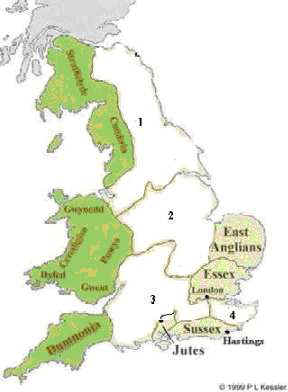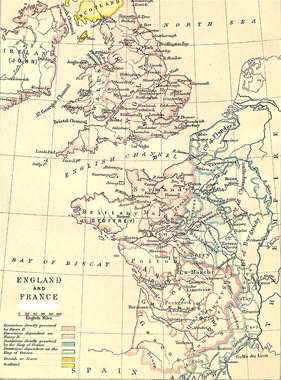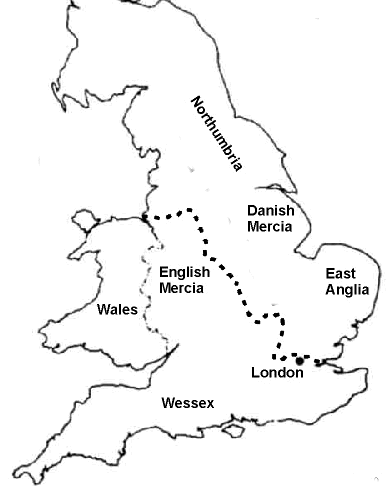Examination A
1.
English is an SVO language. (T/F/)2
. The area known as Dane Law was in …………….. of England (A History of the English Language page 95)A. the north east B. the south east and midlands C. the south west D. north west
Part of Northumbria, Danish Mercia and East Anglia
3. There is massive borrowing in English from (A History of the English Language page 121)
A
. Celtic B. Italian C. French D. SanskritAfter the victory of William the Conqueror in 1066, French became the mother tongue of the Upper classes while the rest spoke English. However with time, during the kingdom of Henry II (1133-1189) there was a knowledge of both languages by the Upper and Middle classes.
4.
Name a sister language of English. Catalan because shares the characteristic of having to borrow from other languages due to historical contexts. While English borrowed from French, Catalan borrowed from Spanish.5
. The Adventus Saxonum under the leadership of Horsa and Hengest took place in (A History of the English Language page 47)A
103 BC B. 449 C. 1066 BC D. 16016
. Caxton publishes Chaucer's works in (A History of the English Language page 195)A
1066-1067 B 1475-1476 C 1842-1843 D 1650-1651The introduction to the printing press of Caxton started in 1476. The first edition of The Canterbury Tales was published in 1478.
7
What is the reason for the similarity between these words?A.
English ma and Chinese ma "mother," 1. Random similarityB.
English cuckoo and Spanish Cuco "bird" 2. Same language familyC.
English goober and Bantu nguba "peanut" 3. BorrowingD.
English brother and Russian brat "brother." 4. Onomatopoeia (2 points)A. English ma and Chinese ma "mother," 2. Same language family
B. English cuckoo and Spanish Cuco "bird" 4. Onomatopoeia
C. English goober and Bantu nguba "peanut" 1. Random similarity
D. English brother and Russian brat "brother." 3. Borrowing
8. Russian is to Slavic what ………. is to Germanic. (A History of the English Language page 39)
Slavic derived into Russian. Slavic used words in Avestan.
Centum derived into Germanic. Centum used words in Latin.
9. Where did Sir William Jones discover the relationship between English, Latin and Sanskrit?
A
In England B. In Greece C. In India D. In ItalyW. Jones went to India in 1783 and learnt Sanskrit seeing the similarities with the other languages.
10
. Important places. What happened here: (2 points)A
. Lindisfarne 1. A monastery which was burnt downB
. Hastings 2. King Alfred’s reigned hereC
. Stratford-on-Avon 3. A battle between the English and the NormansD
. Wessex 4. Shakespeare's was born hereA. Lindisfarne 1. A monastery which was burnt down
B. Hastings 3. A battle between the English and the Normans
C. Stratford-on-Avon 4. Shakespeare's was born here
D. Wessex 2. King Alfred’s reigned here
11. Important people. What did they do? (2 points)
A.
Chaucer 1 Translated works from Latin into EnglishB.
Alfred the Great 2. Wrote the Canterbury TalesC.
Duke William of Normandy 3. Introduced printing pressD.
Caxton 4. Invaded England and brought in FrenchA. Chaucer 2. Wrote the Canterbury Tales
B. Alfred the Great 1 Translated works from Latin into English
C. Duke William of Normandy 4. Invaded England and brought in French
D. Caxton 3. Introduced printing press
12.
The endings –by, –thorpe and –thwaite are from (A History of the English Language page 98)A.
Danish B. Norman C. Anglo-Saxon D. Celtic-by (farm or town)
-thorpe (village)
-thwaite (an isolated piece of land)
13. Natural gender was a characteristic of
A. Old English B. Middle English14. Who made this complaint?
“what sholde a man in thyse dayes now wryte, egges oreyren/certaynly it is harde to playse euery man/by cause of dyuersite & chaunge of langage” (Virgil's Aeneid (1490)
)A.
Webster B. Caxton C. Alfred the Great D. The Venerable Bede15. Which Germanic tribe settled in Kent?
A. Angles B. Danes C. Jutes D. Saxons (A History of the English Language page 49)16. The Heptarchy refers to the division of England into ………….. kingdoms. (A History of the English Language page 50)
A.
5 B. 6 C. 3 D. 71.Northumbria
2.Mercia
3.East Anglia
4.Kent
5.Essex
6.Sussex
7.Wessex
17. The Authorized version of the Bible was written during the reign of (Lord's Prayer in Old English
)A. James the 1
st B. Alfred the Great. C. Harold Godwinson D. King Charles 1st.18. Write the letter in front of each of these four kingdoms after the correct number. (2 points) (A History of the English Language page 54)
A. Kent B. Northumbria C. Wessex D. Mercia.
1. B. Northumbria 2. D. Mercia 3. C. Wessex 4. A. Kent

19. The words Avon, dun, binn, crag and Dover are of (A History of the English Language page 75-76)
A.
Danish origin B. Norman origin C. Anglo-Saxon origin D. Celtic originAvon (Name of a river)
Dun (dark colored)
Binn (basket, crib)
Crag (lake)
Dover (Name of a river)
20. Palatalization is a characteristic of northern English T/F (A History of the English Language page 79)
21. Match the following (
2 points)A. Weakening 1. pater > padre (It.)
B. Metathesis 2. pater > pare (Cat.)
C. Vowel harmony 3. evangelium > godspel > gospel
D. Calque 4. pater > pere (Fr.)
D. Calque 3. evangelium > godspel > gospel
22. Give the name of a daughter language of Latin. Spanish.
23. Claudius’ general invaded in 45 AD. T/F (A History of the English Language page 46)
Claudius invaded in 43 A. D
24. What was the name of the wall built to keep the Picts and Scots out of Roman Britain?
A. Caeser’s Wall B. Harold’s Wall C. Hadrian’s Wall D. Claudius’ Wall
25. What happened at Stamford bridge? (bayeuxtapestry)
A. A battle between Harold and the Normans B. A battle between Harold and the Vikings
C. The signing of the a treaty between the Danes and Alfred. D. The burning of a monastery.
Harold Hardrada (1015-1066), King of Norway. Died at the Battle of Stamford Bridge (September 1066) defeated by Harold Godwinson.
26.
Chester comes from the Latin word meaning ……………..A. Cottage B. Cattle C. Castle D. Carriage
28. What happened in AD 407/410 (A History of the English Language page 47)
A. The Romans invaded Britain. B. The Vikings controlled England.
C. The Romans left Britain D. The Anglo-Saxons conquered England.
29. Mercia was and English kindom in the
A. South B. North C. West D. Midlands
30.
St. Augustine was sent to Christianize Britain from the year. (A History of the English Language page 82)A. 1066 B. 597 C. 54 BC D. 1238
31. This is a map of Britain and France around
A. 1066 B. 1185 C. 45BC D. 1600

32. The following is a case of simplification of
A. Article system B. Noun declensions C. Adjective system D. Verb system
Nom
se > þeAcc
þone > þeDat
þǽm > þeGen
þæs > þe33. The only cases that survive in Contemporary English nouns are
A. Nominative and Accusitive B. Nominative and Dative
C. Accusative and Genitive D. Nominative and Genitive
34. The following phrasal verbs:
gyfen up, faren mid, leten up, tacen to came fromA. French loan words B. Anglo-Saxon C. Latin calques D. Viking borrowings
35. Which of the following is not a Celtic word?
A.
wic B. crag C. glen D. loch36. The following words:
pine, cedar, sack, sock came fromA. Latin B. Scandinavian C. Anglo-Saxon D. Celtic
37. The following map shows the high frequency of which words?
A. Latin B. Scandinavian C. Anglo-Saxon D. Celtic
38. The following function
til, though they, their, them words come from?A. Latin B. Scandinavian C. Anglo-Saxon D. Celtic
39. Which of the following words is Norman French?
A.
guarantee (1624) B. regard (1430) C. guile (1225) D. reward (1315)40. The following map shows the division of England which started around: (A History of the English Language page 93)
A. 1066 B. 886 C. 45 AD D. 1400

Academic year 2008/2009
© a.r.e.a./Dr.Vicente Forés López
Barry Pennock Speck
© Carolina Cody Aldaz
cacodyal@alumni.uv.es
Universitat de València Press